


 |
 |
 |
|
THE MIKOYAN-GUREVICH (MiG) 21 FISHBED |
The MiG-21 Fishbed is the most built jet ever. Fast, small, agile dependable, and above all simple, this swept-wing MiG design called "Faceplate" by NATO was turned out in prodigious numbers, flooding the skies above Europe, Asia, Africa,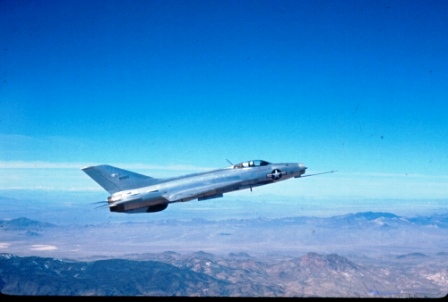 and even Central America with literally thousands of modern, deadly fighters. It has flown in more wars than any other airplane in the world, over 10,000 of them produced by the Soviet Union, it's allies and China with a 30-year record equal, and parallel, to the McDonnell Douglas F-4 Phantom II.
and even Central America with literally thousands of modern, deadly fighters. It has flown in more wars than any other airplane in the world, over 10,000 of them produced by the Soviet Union, it's allies and China with a 30-year record equal, and parallel, to the McDonnell Douglas F-4 Phantom II.
The MiG-21 prowess isn't its target capabilities or range. Known as a pilot's plane partially because it doesn't have any computers or fancy navigation equipment, the swept-wing Fishbed depended on the pilot's training and experience. Though this lack of technology might be termed the MiG-21's Achilles verse, it certainly shocked the Phantom pilots when it arrived in the skies over Vietnam and proved itself over and over as a formidable dogfighter against the heavier American fighters, which was another reason for the success of the MiG-21. An analog to the F-104 in that it is a Mach-2 fighter, its reliable engine, easy maintenance, rough field capabilities, and safe flight characteristic made it the most successful jet aircraft of all times.
In the Vietnam War the Soviet-built MiG-17 Fresco and MiG-21 Fishbed were extracting a 9-1 loss ratio against American pilots. Israel had captured some Soviet assets during the Six-Day War from which they loaned the Air Force a Soviet-built MiG-21F Fishbed from 23 January 1968 to 8 April 1968.
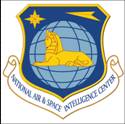 This recent declassification is the genesis of this insider's account about how the CIA with FTD (Foreign Technology Division) leading an exploitation team of specialists drawn from throughout the USAF and USN addressed this disastrous military weakness by exploiting the Soviet MiG-21 and MiG-17. The participants included AFSC (Air Force Systems Command), the Laboratories at Wright-Patterson AFB, the AFFTC (Air Force Flight Test Center), SAC (Strategic Air Command), NDA (National Defense Agency), NASIC (National Air and Space Intelligence Center), NATC (Naval Air Test Center), the NWC (Naval Weapons Center), the TAC (Tactical Air Command), Aeronautical Systems Division (ASD), the CIA contractor cadre, and their facilities at Groom Lake, Nevada. The purpose was to substantiate and supplement existing threat data. The Exploitation included ground and flight testing, consisting of 102 flights (77 flying hours) in 40 days of flying. No ATOLL missiles were included in the deal. They were substituted with AIM-9B Sidewinders where were almost identical.
This recent declassification is the genesis of this insider's account about how the CIA with FTD (Foreign Technology Division) leading an exploitation team of specialists drawn from throughout the USAF and USN addressed this disastrous military weakness by exploiting the Soviet MiG-21 and MiG-17. The participants included AFSC (Air Force Systems Command), the Laboratories at Wright-Patterson AFB, the AFFTC (Air Force Flight Test Center), SAC (Strategic Air Command), NDA (National Defense Agency), NASIC (National Air and Space Intelligence Center), NATC (Naval Air Test Center), the NWC (Naval Weapons Center), the TAC (Tactical Air Command), Aeronautical Systems Division (ASD), the CIA contractor cadre, and their facilities at Groom Lake, Nevada. The purpose was to substantiate and supplement existing threat data. The Exploitation included ground and flight testing, consisting of 102 flights (77 flying hours) in 40 days of flying. No ATOLL missiles were included in the deal. They were substituted with AIM-9B Sidewinders where were almost identical.
Air Force Systems Command had large divisions that handled different aspects of technology: Aeronautical Systems Division, Electronic Systems Division, Armament Division, and others developed new technology for the AF. Foreign Technology Division was (and still is, as NASIC) involved with analyzing foreign military hardware, particularly foreign aircraft, some air defense systems, and space systems. They figured out how foreign fighter jets worked based on any info they could get: signals from the fighters, radar tracks of the fighters, photographs, maybe human sources, whatever they could get. If the engineers could get their hands on real hardware, that would be ideal to fill in gaps in knowledge and confirm things they were able to piece together.
In 1968, FTD was part of the Intelligence Community, as NASIC is today. Intelligence organizations had an intelligence community 'chain of command', separate from their military chain of command. The CIA director was Director of Central Intelligence, and the CIA was only one small part of the community under his (loose) control. Beneath him was a Director of Military Intelligence, who ran the Defense Intelligence Agency, and somewhat controlled all intelligence activities in the DoD. There were service intelligence chiefs as well. Decisions about production of intelligence reports were handled somewhat through the intelligence chain amidst lots of cooperation (and rivalry) among the military services and civilian agencies. Once the intelligence community was involved, there was an honest effort to get all the interested players involved.
Our 1968 TAC inventory used against the MiG-21F-15 included in the offensive and defensive evaluation included our F-4C/D/E, F-105D/F, F-111A, F-100D, F-104D, F-5A. Our defensive evaluation included the RF-101, RF-4C, and B-66.
The purpose of Have Doughnut was to evaluate the effectiveness of existing tactical maneuvers by USAF and USN combat aircraft against the MiG-21. This included exploiting the tactical capabilities in an air-to-air environment, optimize existing tactics and develop new tactics as necessary to defeat the MiG-21, evaluate the design, performance, and operational characteristics of the MiG-21.
The sortie breakdown was:
| USAF Tactical | 33 |
| USN Tactical | 25 |
| USAF Performance, Stability, and Control | 26 |
| Air Defense Command | 4 |
| Strategic Air Command | 2 |
| Infra Red | 9 |
| Radar Cross Section | 1 |
| Photo | 1 |
| Acceptance Flight | 1 |
Only 11 sorties were lost due to equipment problems. The U.S. jets didn't come close to that. Very few shortcomings were observed. They were: visibility, engine response, low altitude transonic vibration, formation flying, flying in turbulence, and night flying.
Unique design features included very low wing loading, lacquer coating for corrosion prevention, ejection system consisting of SK-1 seat and canopy, 3-position air intake, seat position, low maintenance requirements, no roll, pitch, yaw stability augmentation, cooled navigation lights, optimized cross section, and smooth skin only where needed.
We learned the plane had a 8g load factor, poor forward and rearward visibility, extremely slow engine response, slow speed and easy to kill due to non-sealing tanks, unprotected engine, light metal structure, high pressure O2 bottles, giving it a 85% kill probability. Comparison to U.S. planes remains classified.
Engaging the F-4C/D/E against the MiG-21 we learned that the F-4 can control the engagement below 15,000 ft by exploiting the MiG's airspeed limitation and airspeed bleed-off at high G. We learned to orient the attack towards the BiG-2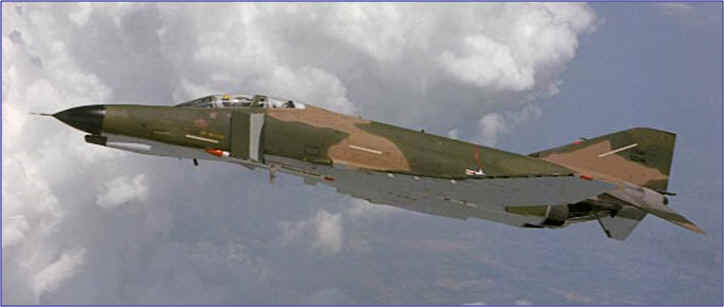 blind cone and operate in the vertical to defeat the MiG-21. The F-4's level acceleration was superior up to 30,000 feet. I had significant advantage in military power, slight advantage in afterburner power. Below 15,000 feet the F-4 could easily accelerate to above the useable airspeed of the M-21.The A-4 had good zoom capability, giving it significant advantage in military power up to 30,000 feet. It had only a slight advantage in afterburner power up to 20,000 feet. The MiG-21 had superior instantaneous turn capability, but lost airspeed more rapidly. With the F-4 we learned to force the engagement to low altitude and keep speed of at least 450 KCAS.
blind cone and operate in the vertical to defeat the MiG-21. The F-4's level acceleration was superior up to 30,000 feet. I had significant advantage in military power, slight advantage in afterburner power. Below 15,000 feet the F-4 could easily accelerate to above the useable airspeed of the M-21.The A-4 had good zoom capability, giving it significant advantage in military power up to 30,000 feet. It had only a slight advantage in afterburner power up to 20,000 feet. The MiG-21 had superior instantaneous turn capability, but lost airspeed more rapidly. With the F-4 we learned to force the engagement to low altitude and keep speed of at least 450 KCAS.
To maintain an advantage the F-4 had to retain a high energy level and accelerate in an unloaded condition as necessary, when defensive establish maximum angle off, maneuver vertically below 15,000 feet - avoid slow speed reversals, avoid prolonged turning engagements - disengage and keep energy for possible re-attack, get into the MiG-21's rear hemisphere blind cone., and most of all run away below 15,000 feet above 0.98 Mach/595 KIAS (Knots Indicated Airspeed) when offensive advantage or mutual support is lost. SPEED WAS LIFE.
Engaging the F-105 against the MiG-21 taught us to press an offensive attack only if initial rear hemisphere advantage existed. We learned to avoid prolonged maneuvering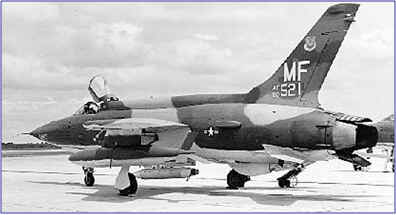 engagements, and to get into the MiG's blind cone, use mutual flight support, and use hit-and-run tactics. We learned to accelerate beyond the MiG-21's airspeed limit below 15,000 feet. Level acceleration matched the MiG-21 up to 15,000 feet. The F-105 could easily accelerate above the .98 Mach/595 KIAS MiG-21 limits. The MiG-2 had a distinct advantage in turn capability at all air speeds and altitudes.
engagements, and to get into the MiG's blind cone, use mutual flight support, and use hit-and-run tactics. We learned to accelerate beyond the MiG-21's airspeed limit below 15,000 feet. Level acceleration matched the MiG-21 up to 15,000 feet. The F-105 could easily accelerate above the .98 Mach/595 KIAS MiG-21 limits. The MiG-2 had a distinct advantage in turn capability at all air speeds and altitudes.
To survive, a F-105 pilot had to use hit and run and not get into a turning fight. The F-105 had equal air-to-air missile capability, but better gun capability - higher rate of fire and better gunsight system. The F-105's APR-25 radar homing and warning equipment did not provide sufficient warning to negate a missile attack by the MiG-21. To survive the F-105 had to maintain maximum airspeed below 15,00 feet when in a high MiG threat area. The pilot had to avoid prolonged maneuvering engagements and no allow airspeed to dissipate below 450 KCAS. The F-105 pilot could not rely on the APR-25 equipment to warn of attack and required good visual scan to see the MiG.
In loss of mutual support and teamwork it was recommended the pilot disengage above MiG-21's airspeed limit below 15,000 feet. If offensive advantage was obtained, maintain at least a 50 knot closure rate and press the attack through missile and gun range then disengage in a descending acceleration above the MiG-21 speed limit, and whenever possible, maneuver toward the blind cone. For the F-105 speed was life and it could only go in a straight line.
The MiG-21 had superior turn performance everywhere when pitted against the F-111. Below 15,000 ft, the MiG-21 had superior level acceleration up to its speed limit.
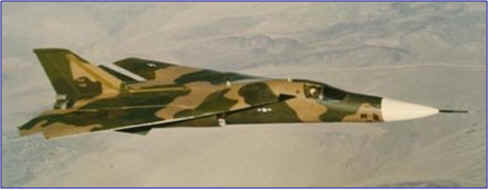 It was learned to avoid maneuvering engagements. When attacked get below 15,000 ft and above the MiG-, speed limit (0.98 Mach/595 KIAS) Use only very high speed hit-and-run attacks from a favorable offensive position. Again ..SPEED WAS LIFE!!! ...and the F-111 could only go in a straight line.
It was learned to avoid maneuvering engagements. When attacked get below 15,000 ft and above the MiG-, speed limit (0.98 Mach/595 KIAS) Use only very high speed hit-and-run attacks from a favorable offensive position. Again ..SPEED WAS LIFE!!! ...and the F-111 could only go in a straight line.
TAC Evaluation of the F-100D revealed the MiG-21 having both significant turn performance and level acceleration advantages. Its missile capability equaled the F-100 gun capability superiority. The F-100 had 4 missiles, MiG-21 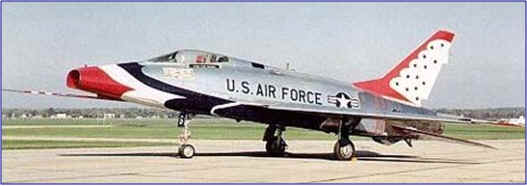 has two, but MiG-21 missile mode radar "in range" and "over G" cue reduce failed shots. The F-100 4 x 20mm cannons and sight were superior. It was learned to avoid maneuvering, use hit-and-run, mutual support and use effective defense accelerating above MiG-21 limit speed. Again...SPEED WAS LIFE!!! ...and the F-100 could only go in a straight line.
has two, but MiG-21 missile mode radar "in range" and "over G" cue reduce failed shots. The F-100 4 x 20mm cannons and sight were superior. It was learned to avoid maneuvering, use hit-and-run, mutual support and use effective defense accelerating above MiG-21 limit speed. Again...SPEED WAS LIFE!!! ...and the F-100 could only go in a straight line.
The TAC Evaluation of the F-104 revealed the MiG-21 having superior turn capability. The F-104 had a slight level acceleration advantage up to 30,000 ft. It had a
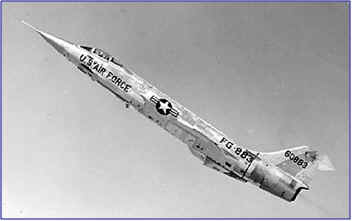 better zoom capability, but shouldn't get slow. The F-104 fire control system was slightly superior, however its IR missile capability was equal to the MiG-21. The F-104 gun had higher rate of fire and superior gunsight. Its F-104 radar was superior to the MiG-21 F range only radar. Results of the evaluation showed the F-104 should avoid maneuvering, use hit-and-run, mutual support and effective defense accelerating above MiG-21 limit speed. Again...SPEED WAS LIFE!!! ...and the F-104 could only go in a straight line.
better zoom capability, but shouldn't get slow. The F-104 fire control system was slightly superior, however its IR missile capability was equal to the MiG-21. The F-104 gun had higher rate of fire and superior gunsight. Its F-104 radar was superior to the MiG-21 F range only radar. Results of the evaluation showed the F-104 should avoid maneuvering, use hit-and-run, mutual support and effective defense accelerating above MiG-21 limit speed. Again...SPEED WAS LIFE!!! ...and the F-104 could only go in a straight line.
The TAC evaluation of the F-5A revealed that within performance limits, the F-5 had considerable capability to engage the MiG-21. The F-5 had performance advantage below 15,000 feet, however the MiG-21 had higher Mach capability at higher altitude. Overall turn comparison was about equal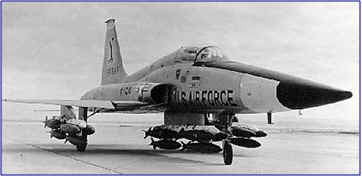 and level acceleration was equal in military power, MiG-21 had a slight advantage in afterburner. They had comparable fire control systems. The F-5 controlled the tactical engagement effectively and if defensive separation was necessary, the F-5 could exceed the MiG-21 airspeed limit below 15,000 ft. The F-5 could closely simulate the MiG-21 up to Mach 1.2 for combat crew training in ACM, dissimilar aircraft engagements.
and level acceleration was equal in military power, MiG-21 had a slight advantage in afterburner. They had comparable fire control systems. The F-5 controlled the tactical engagement effectively and if defensive separation was necessary, the F-5 could exceed the MiG-21 airspeed limit below 15,000 ft. The F-5 could closely simulate the MiG-21 up to Mach 1.2 for combat crew training in ACM, dissimilar aircraft engagements.
The TAC Evaluation of the RF-101 found the most effective defensive maneuver to be unloaded maximum power acceleration to above MiG-21 speed limit below 15,000 ft. Steep descent, 45 deg or greater, when possible, provided background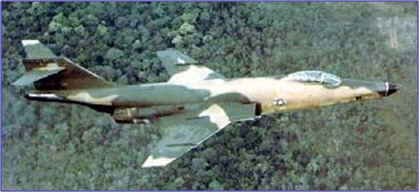 IR clutter, increased acceleration, and forced MiG-into high longitudinal stick force regime. With comparable military power level acceleration, the MiG-21 had a slight advantage in afterburner. The MiG-21 had superior turn capability everywhere. When caught by a MG-21 dive and run...SPEED WAS LIFE!
IR clutter, increased acceleration, and forced MiG-into high longitudinal stick force regime. With comparable military power level acceleration, the MiG-21 had a slight advantage in afterburner. The MiG-21 had superior turn capability everywhere. When caught by a MG-21 dive and run...SPEED WAS LIFE!
The TAC Evaluation of the B-66 showed to be extremely vulnerable to attack. Escort protection should be mandatory in a high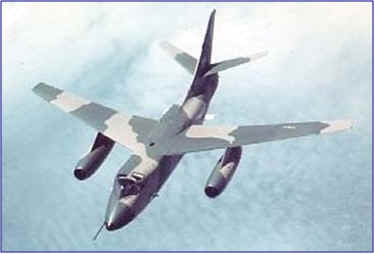 MiG threat environment. Survivability depended on escort effectiveness and teamwork. 3 G defensive spiral, considered maximum performance would not negate a MiG-21 missile or gun attack. Descending spiral would assist escort in positioning and may buy time for escort to perform diversionary missile launch or obtain a kill. The B-66 was a target.
MiG threat environment. Survivability depended on escort effectiveness and teamwork. 3 G defensive spiral, considered maximum performance would not negate a MiG-21 missile or gun attack. Descending spiral would assist escort in positioning and may buy time for escort to perform diversionary missile launch or obtain a kill. The B-66 was a target.
The TAC Evaluation RF-4C found the.QRC-353A chaff dispenser could effectively deny radar ranging information for  the MiG-21 F. However, the MiG pilot could estimate range visually for a missile attack or use the optical sight manual ranging mode for gun firing defensive maneuver is to get above the MiG-21 speed limit below 15,000 ft. When caught by a MiG-21 dive and run...SPEED WAS LIFE!
the MiG-21 F. However, the MiG pilot could estimate range visually for a missile attack or use the optical sight manual ranging mode for gun firing defensive maneuver is to get above the MiG-21 speed limit below 15,000 ft. When caught by a MiG-21 dive and run...SPEED WAS LIFE!
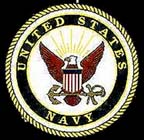 The U.S. Navy evaluated the F-4B/J, F-8E, A-4F, A-6A, and A-7A against the MiG-21F-13. The USN Evaluation of the F-4B/J reached the same conclusions as for the USAF F-4 plus the MiG-21 on station time was comparable, however large size and prominent smoke trail proved to be a disadvantage. During ACM with the MiG-21, the Radar Intercept Officer had to devote the majority of his time and effort to maintaining visual contact.
The U.S. Navy evaluated the F-4B/J, F-8E, A-4F, A-6A, and A-7A against the MiG-21F-13. The USN Evaluation of the F-4B/J reached the same conclusions as for the USAF F-4 plus the MiG-21 on station time was comparable, however large size and prominent smoke trail proved to be a disadvantage. During ACM with the MiG-21, the Radar Intercept Officer had to devote the majority of his time and effort to maintaining visual contact.
The USN evaluation of the F-8E found that the MiG-21 could out turn the F-8 in a close-in fight.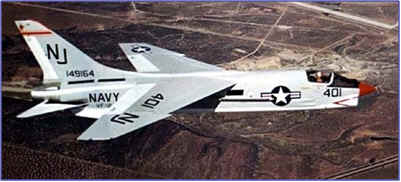 Zoom performance was comparable below 25,000 ft and on station time was also comparable. Large size and prominent smoke trail was a disadvantage. The F-8E was capable of exceeding the MiG-21 speed limit at low altitude. Acceleration performance was better than the MiG-21 at low and medium altitudes below 1.2 Mach.
Zoom performance was comparable below 25,000 ft and on station time was also comparable. Large size and prominent smoke trail was a disadvantage. The F-8E was capable of exceeding the MiG-21 speed limit at low altitude. Acceleration performance was better than the MiG-21 at low and medium altitudes below 1.2 Mach.
The MiG-21 size and shape looked very similar to an A-4. The 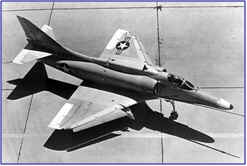 A-4, A-6, A-7 possessed sufficient maneuverability in an initial break turn to thwart a MiG-21 attack. However, resulting energy loss allowed the MiG-21 to reattack
A-4, A-6, A-7 possessed sufficient maneuverability in an initial break turn to thwart a MiG-21 attack. However, resulting energy loss allowed the MiG-21 to reattack with comparative ease if the A-4/6/7 stayed in the fight at slow speed. The MiG-21 pilot could chose to engage or disengage the A-4, A-6, A-7 aircraft at will. The A-4 and A-6 could reverse and obtain a quick snap-shot if the MiG-21 overshot close-in. A-7A did not appear to have the necessary thrust to complete this nose high maneuver. The A-7 was a target, but with a chance to live!!!
with comparative ease if the A-4/6/7 stayed in the fight at slow speed. The MiG-21 pilot could chose to engage or disengage the A-4, A-6, A-7 aircraft at will. The A-4 and A-6 could reverse and obtain a quick snap-shot if the MiG-21 overshot close-in. A-7A did not appear to have the necessary thrust to complete this nose high maneuver. The A-7 was a target, but with a chance to live!!!
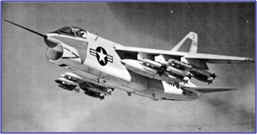 The ADC Evaluated the F-106 and found its radar capable of acquisition and that radar snap-up attack with all aspect armament should be used to exploit MiG-21 lack of
The ADC Evaluated the F-106 and found its radar capable of acquisition and that radar snap-up attack with all aspect armament should be used to exploit MiG-21 lack of 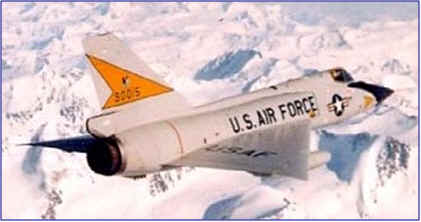 fire control. The F-106 could use better acceleration to get beyond MiG-21 speed limit if not in an advantageous position. The F-106 should use missiles then close in to gun kill position. It was the consensus of ADC that the U.S. needed to expedite procurement of cannon for F-106, and replacement of its canopy bar with clear pane. It was concluded that the F-106 shouldn't attempt a slow speed turning contest and should keep its speed from 400-450 KCAS during patrol and engagement.
fire control. The F-106 could use better acceleration to get beyond MiG-21 speed limit if not in an advantageous position. The F-106 should use missiles then close in to gun kill position. It was the consensus of ADC that the U.S. needed to expedite procurement of cannon for F-106, and replacement of its canopy bar with clear pane. It was concluded that the F-106 shouldn't attempt a slow speed turning contest and should keep its speed from 400-450 KCAS during patrol and engagement.
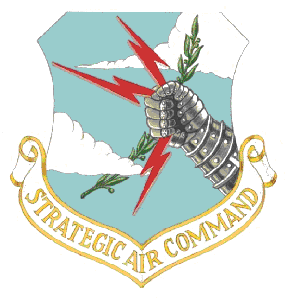
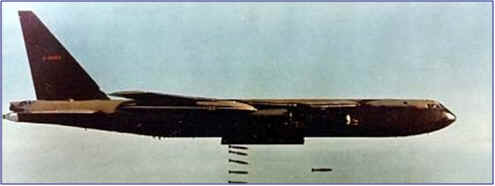 The SAC evaluation of the B-52 and B-58 showed that the B-58 T4 deception jammer worked. During a 6 second cycle, true range was momentarily displayed. The B-52 modified ALR-18 with pulse modulations could introduce a constant 1-3 km range error. Chaff broke radar lock every time it was dispensed. Breaking radar lock of the MiG-21 range only was not profitable; a deceptive range technique could force the pilot to shoot his beyond max range.
The SAC evaluation of the B-52 and B-58 showed that the B-58 T4 deception jammer worked. During a 6 second cycle, true range was momentarily displayed. The B-52 modified ALR-18 with pulse modulations could introduce a constant 1-3 km range error. Chaff broke radar lock every time it was dispensed. Breaking radar lock of the MiG-21 range only was not profitable; a deceptive range technique could force the pilot to shoot his beyond max range.
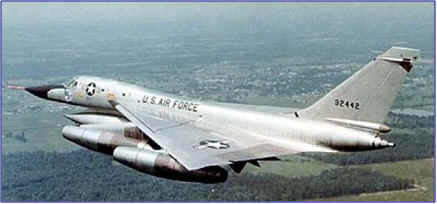 As a result of Project Have Doughnut the Navy created the TOP GUN Weapons School in 1969 and experienced strong results against the MiG-21 when they encountered it in 1972. The Air Force created a similar air combat program, Red Flag in 1972.
As a result of Project Have Doughnut the Navy created the TOP GUN Weapons School in 1969 and experienced strong results against the MiG-21 when they encountered it in 1972. The Air Force created a similar air combat program, Red Flag in 1972.
In 1969, the CIA undertook a program at Groom Lake to evaluate the MiG-17 to help fight the Vietnam War during a period of anti-Vietnam War protests and the North Korean GiG-17s and MiG-21s performing well against the U.S. F-4 Phantom. These programs were code-named HAVE DRILL and HAVE FERRY. I became a member of these ultrasecret programs after being "recruited" from my position of electronic engineer and technical advisor on the Beatty station of the NASA High Range Tracking Station for the X-15 and XB-70. Like most recruited by the CIA for its black projects within Area 51, I wasn't told what I would be doing, where I would be doing it at, or with whom I would be doing whatever the CIA wanted done. At the time, the name Area 51 conjured images of government conspiracy and unexplained mysteries. Of course, I volunteered.
I soon learned that during the "Six Day War", Israeli forces had captured several Soviet-designed fighters, and was shipping them to Groom Lake for back engineering and testing under the Defense Intelligence Agency Project "HAVE DRILL." I arrived at Groom Lake where I joined a small, highly specialized group of engineers and technicians wrapping up the CIA's A-12 Oxcart program that ended the following year.
Projects HAVE DRILL and HAVE FERRY involved trials of MiG-17F Frescos over the skies of Area 51 at Groom Lake, while Project DOUGHNUT was an USAF evaluation of the MiG 21. In addition to my group tracking the dog fights staged between the various MiG models against virtually every fighter in U.S. service, and against SAC's B-52 Stratofortress and B-58 Hustlers to judge the ability of the bombers' countermeasures systems, we performed radar cross-section and propulsion tests that contributed greatly to the improvements in our aerial performance in Vietnam. Our group was, during this period, involved in the early stages of Projects HAVE BLUE (stealth) "SENIOR TREND" (F-117), and TACIT BLUE.
The MiG-17 (NATO code name Fresco) was the first Soviet fighter to have an afterburning engine, the Klimov VK-1. Although similar in appearance to the MiG-15, the MiG-17 has more sharply swept wings, an afterburner, better speed and handling characteristics and is about three feet longer. The wings of the aircraft are mid-mounted, swept-back, and tapered with blunt tips. They have wide wing roots. The engine is one turbojet inside the body and has a round air intake in the nose. It has a single, small exhaust. The fuselage is short, thick, cigar-shaped and tapered to the rear. It has a blunt nose and bubble canopy. The tail fin is swept-back and tapered with rounded tip. Flats are high-mounted on the tail fin, swept-back, and tapered. Flats and fin overhang the exhaust. The MiG-17PFU was armed with four AA-1 "Alkali" radar-guided missiles, making it the Soviet Union's first missile armed interceptor.
The HAVE DRILL MiG-17 was a Lim-5 serial number 1C-07-18, built in Poland in 1956-57. The HAVE DRILL aircraft arrived at Groom Lake on 27 January 1969 with its first flight being on 17 February 1969. It flew 172 sorties for 131 hours covering 55 days. The HAVE FERRY arrived on 12 March 1969 with first flight on 9 April 1969. It flew 52 sorties for 37.7 hours over 20 days. The HAVE DRILL aircraft was instrumented with periscope, Scan-Fix radar.. The HAVE FERRY was a backup aircraft with no periscope or radar. Above Mach .85 control very heavy (2 hands) with a 8g limit. In 224 flights, only 23 major discrepancies occurred and only two missions were lost. It was spun once (fully developed) during flight test. Spun to the left, full rudder did nothing for four turns, popped stick full forward (to white line). It recovered after 23 seconds/3,000 feet. Its controls did not have pitch, roll, or yaw stability augmentation and only the ailerons were hydraulically boosted. The rudder/elevator was manual.
For the technical phase of HAVE DRILL FFTC personnel replaced the clock, airspeed indicator, altimeter, and accelerometer, plus installed a machmeter. A voice tape recorder was installed in cockpit along with a photo recorder for instruments in the nose compartment. A 14-channel oscillograph was mounted in gun platform where ammo boxes were originally. It weighed 75 pounds and recorded fuel flow/temp, OAT, engine RPM, airspeed/altitude, control surface positions, attitude, roll-pitch-yaw rates, acceleration and the EVENT button.
The MiG-17F cockpit was an antiquated design and cramped for a man over 6 feet. The seat was not adjustable. The periscope was excellent. We modified the cockpit G meter, intervalometer, airspeed, altimeter, machmeter, EGT/Tac, tape recorder UHF radio, and OSC/Event instruments and/or controls.
During the technical phase we learned a lot by exploiting the SRD-1 SCAN FIX, SRO-2 IFF, VHF radio, and SIRENA RWR. We analyzed the VK-2F engine, infrared/acoustic/radar measurements and conducted a vulnerability study. It had differential braking and was difficult to steer. The internal fuel tank held 375 gallons, about 20 - 25 minutes of flying. The plane was hard to see, little and clean. The pilots flying the MiG 17 said, "Hydraulics - Who needs them"?
The pilots distrusted the ejection seat propellant stability because they were probably beyond the service limits. In general they were as reliable as the US planes. The later K-36 series were more stable at high speeds than our seats due to the booms they "borrowed" from the B seat in the F-106 and the X-15 seat. But at low altitude they were slower than our sequenced seats. After the early 90s they fixed that so they are world class seats.
As we advanced from the technical phase of HAVE DRILL to the tactical we had obviously had a purpose - that being to determine the effectiveness of existing tactics employed by US airplanes and associated weapons systems against the MiG-17. To that end we proceeded to exploit the tactical capabilities and limitations of the MiG-17 in the air-to-air environment when employed singly and in section against US tactical airplanes. We sought to optimize existing tactics and develop new tactical techniques as necessary to defeat the MiG-17. To this end we evaluated the design, performance, and handling qualities of the MiG-17 and in the process expose USAF and USN tactical aircrews to simulated combat with an aggressively flown MiG-17.
Weapon System Highlights included its 37mm cannon with 40 rounds, its 27mm cannon with 80 rounds each with an approximately 6 seconds of continuous firing time. The plane had an optical gyroscopic lead computing optical sight, Range only radar, Sirena radar warning receiver (tail aspect only, and a SRO-2 Identification Friend or Foe Transponder. It had no airborne intercept radar or missiles. All in all, it was not very sophisticated for 1969!
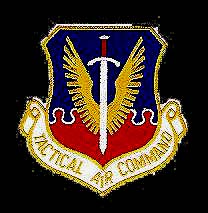 Fifty-seven Tactical Air Command missions were conducted with the MiG-17F. Eleven missions were flown with the F-4C/D Phantom II, and 18 with the F-43 Phantom II, 11 with the F-105D/F Thunderchief, 6 missions with the F-100D Super Sabre, 2 with the F-5A Freedom Fighter. Five missions were conducted for air-to-air gunnery and 5 with air-to-ground gunnery. Two missions were flown for photo/pilot checkout.
Fifty-seven Tactical Air Command missions were conducted with the MiG-17F. Eleven missions were flown with the F-4C/D Phantom II, and 18 with the F-43 Phantom II, 11 with the F-105D/F Thunderchief, 6 missions with the F-100D Super Sabre, 2 with the F-5A Freedom Fighter. Five missions were conducted for air-to-air gunnery and 5 with air-to-ground gunnery. Two missions were flown for photo/pilot checkout.
The TAC evaluation of the MiG-17F Limitations and Deficiencies revealed that above 0.85 Mach or 450 KIAS high control forces resulted in a very slow roll rate and pitch change capability. It had a Dutch Roll tendency above 375 KIAS and difficult yaw control in turbulent air at any speed. Its weapon limitations included:
- Low firing rate (900 rpm 23 mm, 400 rpm 37mm)
- Low muzzle velocity (2250 fps)
- Excessive tracking time for lead computation (2-3 seconds)
- Large lead required due to low muzzle velocity and projectile weights
When TAC evaluated the conduct of the F-4C/D/E against the MiG 17 it found the effectiveness of the F-4 radar and radar missile system to be substantially reduced when the MiG-17 operated at or below 10,000 ft AGL. TAC concluded that tactics against the MiG-17 should emphasize mutual, support and split plane maneuvering the MiG-17 is superior in the high AOA max performance maneuvering and low speed (250 KIAS or slower) arena the F-4, F-105, F-100, and F-5 all have vertical maneuvering superiority. This could be a decisive advantage for the F-4 and F-5 with a low G pitch to vertical MiG-17 lethal position can be defeated above 450 KIAS rapid unloaded reversals and 30-60 deg check turns maintaining high calibrated airspeed. Accelerating at 30-60 deg nose low during escape can force the MiG-17 pilot "into a realm of flight wherein his capability to pull out becomes his dominate consideration.
The MiG-17 was very difficult to acquire with the unaided eye. The F-5 was also difficult, whereas the F-4 was by far the easiest to locate and engage. It was noted during the exercises at Groom Lake that all the pilots made serious misjudgments in range during first encounters. Where the F-4 was noted for its trail of smoke from its engine, the MiG 17 had a negligible exhaust trail. The exercises at Groom Lake established the Southeast Asia fighter wing tactical doctrine to be generally quite accurate for the MiG-17 but should be updated to incorporate the findings from the Groom Lake exploitation program. The tactics in AFM 3-1 were determined to still be valid. The F-4 and F-105 APR-25/26 radar-warning receiver was only able to warn of MiG-17 radar presence in range.
General recommendations from the Tactical Air Command's evaluation were to develop flight tactics that emphasized mutual support between elements and split plane maneuvering. Our pilots should employ superior acceleration and vertical maneuvering to control engagements with the MiG-17. Elimination of exhaust trails was a primary engine design consideration for future US fighters. Wing fighter doctrine would be updated to include test findings and combat crew training would address aircraft with various performance characteristics. Steep dive angles would be used to disengage if conditions permitted. Pilot would keep ingress speed high to permit rapid acceleration to negate a M iG-17 gun attack from the rear. Crews must know how tough it is to see MiG-17 size aircraft.
Following initial confrontation and subsequent separation from a MiG-17 in a one-on-one situation the F-4 aircrews would not reattack without sufficient separation (2.5-3 miles) while maintaining visual contact. The F-105, F-5, and F-100 Aircrews would avoid attempting to reattack unless they enjoyed a tactical advantage. Most importantly - If they got away, they didn't go back unless it was on their terms!
The U.S Navy flew 47 missions with the MiG-17F included eighteen missions with the F-4B/J Phantom II, 16 with the f-8H/J Crusader, 4 with the A-4F Skyhawk, 4 with the A-6A Intruder, and 4 with the A-7A Corsair II.
After it's evaluation, the USN concluded that the MiG-17 was capable of defeating any USN tactical airplane in a turning fight at and below 475 KIAS. The camouflage paint and small size made visual acquisition and retention difficult (Must keep visual contact). The Q limit seriously inhibited MiG-17 total effectiveness, plus it was extremely fuel limited. Head on visual ID in the F-4 was not effective and it was hard to acquire the MiG-17 on radar. The smoke trail of the F-4 made it visually acquired at longer range by MiG-17 pilot. The Navy concluded that two F-4s could remain 100% offensive against two MiG planes due to overall performance superiority, however USN attack airplanes would have no offensive capability against the MiG-17.
Recommendations from the USN as a result of this evaluation were that USN fighters should maintain a high energy level ' 500-600 KIAS, avoid high G maneuvers below 500 KIAS, use thrust advantage to prevent MiG-17 from getting gun position, force the MiG-17 to fight above 475 KIAS, engage only as a section with strict mutual support. The Navy would use afterburner judiciously to take advantage of low MiG-17 and would exploit MiG-17 weaknesses of being blind area below the horizontal; its poor roll rate, and marginal control at high q. Pilots would use when necessary max rate/min radius turns 2-3nm from the MiG-17 and reverse based on energy and tactical situation.
The U.S. Navy further recommend that the A-4, A-6, and A-7 should not engage the MiG-17 and if the A-4, A-6, or A-7 were engaged by the MiG-17 they should jettison non air-to-air stores and unload, dive, and accelerate. They would utilize maximum roll rate and run out at maximum airspeed and minimum altitude. If reversal or turn was necessary ensure range is at least 2-2 nm from the MiG-17 then max turn to pass head on. Pilots would maintain strict lookout in enemy territory while weaving and vary headings in a threat area. They should practice realistic air combat maneuvering (ACM) as much as possible against small airplanes with low wing loading. Whenever possible the Navy would train over land with the pilots practicing abd coaching RIOs on targets. Squadron training of RIOs and BNs be intensified for ACM training for attack aircrews be intensified at all levels.
 The ADC, Air Defense Command conducted 13 missions with the F-106A Delta Dart, 5 missions with the F-102A Delta Dagger, and 5 with the F-104A Starfighter. Following the missions at Groom Lake the ADC recommended the expediting fitting the internal gun, redesigned canopy radar warning, and ECM equipment into the F-106. Tactics development should continue and the time required reduced to prepare and fire missiles from the F-102. The F-102 units go to four-ship tactics instead of two-ship. All future US fighter developments include a gun as well as missiles. Future US fighter developments include extensive maintainability/reliability studies with eye toward simplifying avionics, fire control, and general systems.
The ADC, Air Defense Command conducted 13 missions with the F-106A Delta Dart, 5 missions with the F-102A Delta Dagger, and 5 with the F-104A Starfighter. Following the missions at Groom Lake the ADC recommended the expediting fitting the internal gun, redesigned canopy radar warning, and ECM equipment into the F-106. Tactics development should continue and the time required reduced to prepare and fire missiles from the F-102. The F-102 units go to four-ship tactics instead of two-ship. All future US fighter developments include a gun as well as missiles. Future US fighter developments include extensive maintainability/reliability studies with eye toward simplifying avionics, fire control, and general systems.
So what did we learn in Projects Have Doughnut, Have Drill and Have Ferry? In testing the MiG-17 at its best speed advantage (300-350 KIAS) we couldn't outturn it. It left no smoke trail. SCAN FIX lit the AAA warning light. Its combat radius was 115nm clean, 215nm with tanks. The aircraft was extremely reliable - easily flying 4-5 sorties a day. It fired 37mm/23mm guns that did massive damage on the truck and other targets we used at Groom Lake for the gun tests.
The great majority of tactical engagements against the MiG-17F in SEA had been in the low altitude regime where the FRESCO C low wing loading and 8 g structural limit was best optimized and utilized. It was the outstanding maneuverability of the airplane in this area that permitted this rather old and simple fighter airplane to remain such a potent threat in that day of sophisticated modern weaponry. All Navy project pilots agreed that prior to their first engagement they had seriously underestimated the capabilities of the Fresco C. USAF AFFTC said the performance qualities of the Fresco C were accurately defined in the energy maneuverability charts contained in FTD-CS-09-5-67. USAF FTD (Foreign Technology Division) said substantial information concerning the actual capabilities of the Fresco C was available prior to Project Have Drill. In all significant cases this information was validated by the results of this project.
According to the U.S. Navy the MiG-17 capabilities should have surprised no one! Its pilots were losing the air war due to OVERCONFIDENCE-COMPLACENCY-POOR TRAINING. "It was difficult to acquire and retain visual contact of the Fresco C in the ACM environment. Fighter aircrews were no acutely aware of the visual acquisition problem presented by Fresco C size targets prior to, during, and subsequent to an engagement.'
The Navy certainly had solid grounds for its concern about pilot overconfidence and complacency. Every Navy pilot engaged in the project at Groom Lake lost his first engagement with the Fresco C. The Fresco's over performance in the ACM (Air Combat Maneuvering) environment surprised all crews concerned with the project. The A/B on the Fresco engine gave it a performance level that could not be duplicated or real simulated by U.S. airplanes with similar turn capability. Thus U.S. pilots were not accustomed to fighting an airplane with such an engine/turn performance combination. The relative age of the Fresco also led general overconfidence by U.S. crews prior to their engagement. There were no U.S. Navy airplanes that could simulate performance of the Fresco C. Consequently; the aircrews who fought the Fresco during the test had no CAN training against this type airplane. The great improvement in U.S. Navy aircrew performance after only on simulated ACM engagement dramatically illustrated the lack of realistic ACM training.
 |
 |
 |